Shavasana - The Pose, Modifications and Alternatives
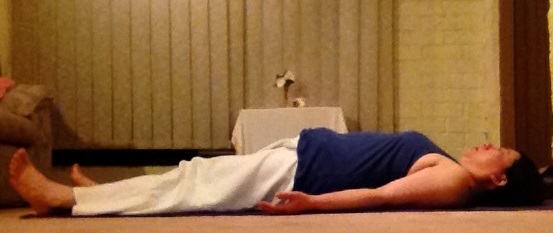 Shavasana. Simple pose right? Just lay down on the floor on your back.
Shavasana. Simple pose right? Just lay down on the floor on your back.
But once you're in the pose, how relaxed are you? Is your spine straight? Can you feel tension in your legs? back? shoulders? neck? Are thoughts racing around in your head?
Shavasana is a pose of total relaxation at both the physical and mental levels, which can make it one of the more difficult poses to do.
Note:
Shavasana is not suitable for:
- Women who are pregnant and approaching or in their third trimester
- People who are extremely uncomfortable laying on their backs
Some people with back problems can perform shavasana with modifications.
Setting up in shavasana
- Lay down on the floor on your back, legs extended and hands by your side.
- Bend your knees, place your feet on the floor and then raise your hips and back off the floor.
Caution: If you have problems with your shoulders or neck, only come up as far as comfortable to avoid supporting your weight with your shoulders and neck.
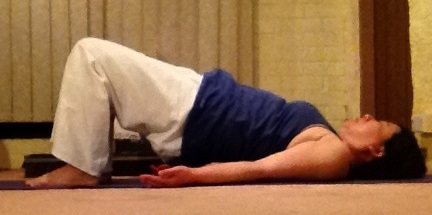
- Lower your body vertebra by vertebra to ensure that your spine is straight, and then extend the legs.
- Ensure that:
- The feet are about hip width apart and let the feet naturally fall out
- The hands are by your side with the palms face up and the fingers curling naturally
- The shoulders are down and back, not tense up against your neck
- The neck is long by drawing your chin a little towards the chest
- If your lower back is arching off the floor, place blankets, cushions or a bolster under your thighs or knees to let your lower back flatten against the floor.
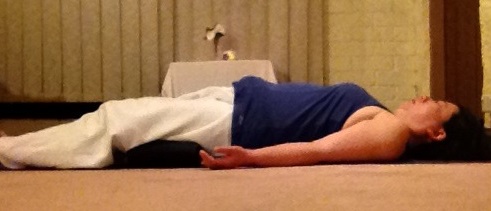
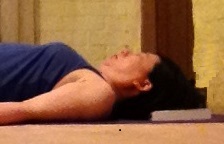 If you have rounding in the upper back that causes your head to come off the ground when you lengthen your neck, use padding or a book under your head to support it. Don't let the head fall back so that the chin is pointing upwards; it places strain on the neck.
If you have rounding in the upper back that causes your head to come off the ground when you lengthen your neck, use padding or a book under your head to support it. Don't let the head fall back so that the chin is pointing upwards; it places strain on the neck.
Modifications
For people with back problems, do one or both of the following:
- Place padding under the thighs (as much as required) to let the lower back flatten against the floor
- Place padding or a book under the head to let the chin come towards the chest a little to lengthen and ease tension in the neck
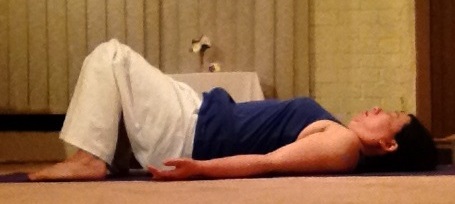 If there is no padding to place under the thighs to support the lower back:
If there is no padding to place under the thighs to support the lower back:
- Bend the knees and place the feet on the floor about hip width apart.
- Ensure that the lower back is flat on the floor and then let the knees fall together.
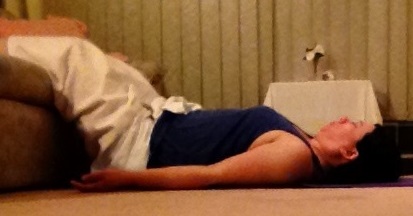 Another modification for those with lower back problems is to rest the lower legs on low piece of furniture.
Another modification for those with lower back problems is to rest the lower legs on low piece of furniture.
Caution: This modification is not recommended for people with very high blood pressure, vertigo, heart conditions or any conditions related to pressure in the head such as glaucoma or sinus congestion. Having the legs above the head causes increased blood flow to the heart and head.
If there is no padding to place under the head, use whatever is available and suitable (for example, I've been in classes where joggers and handbags have been used) or choose an alternative pose.
Alternative poses
An alternative pose for shavasana is the flapping fish pose (matsya kridasana).
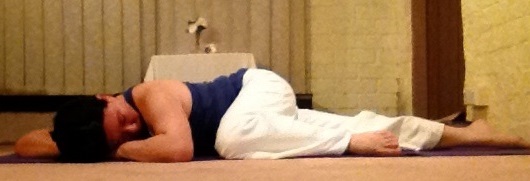
- Lay on your stomach (or towards your right side, if this is uncomfortable) with your legs extended.
- Bend the left leg sideways and bring the knee towards the ribs.
- Bend the arms bringing elbows out to side and place one hand on top of the other.
- Move arms around to the left so that the left elbow is close to the left knee.
- Rest your head in your arms.
Flapping fish is particularly beneficial if you are pregnant. Use cushions and blankets to support the head and upper leg to aid relaxation.
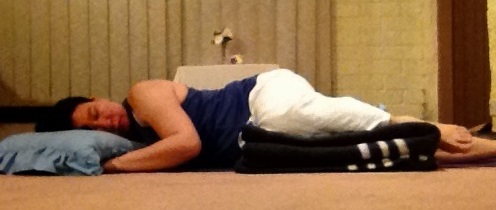
References
Refer to the following websites for more information about shavasana and modifications:
- Satya Live Yoga relaxation asanas details the relaxation asanas including shavasana and the flapping fish pose
- Lying Down for Back Pain Relief describes variations for those with back and hip pain
- Savasana (corpse pose) for big butts demonstrates how to use props to support your lower back and neck
- Third Trimester - Shavasana or Corpse Pose demonstrates how to use props for to support yourself in your third trimester
